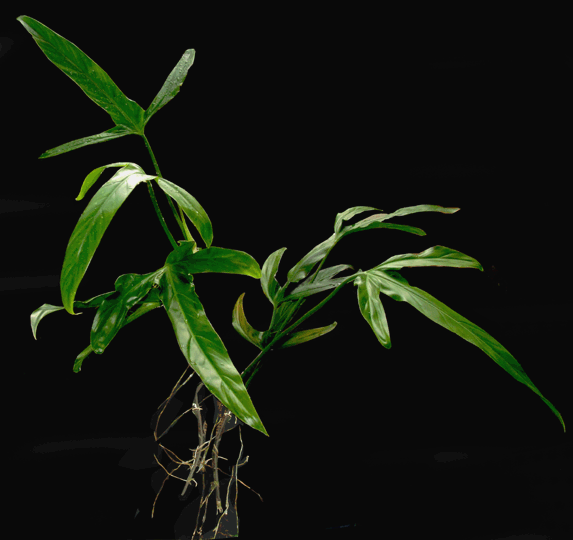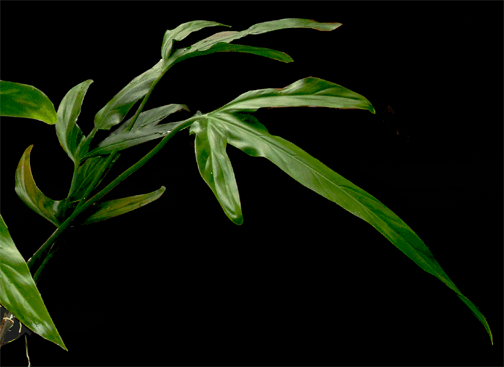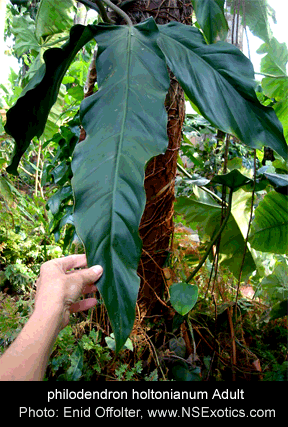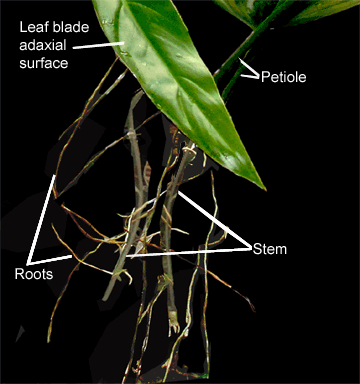![]()
Aroids and other genera in the Collection
Take the Tour Now?
Orchids
The
Exotic Rainforest
Plants in
the Exotic Rainforest Collection
The images on this website are copyright protected. Please contact us before any reuse.
In depth information on how to grow Philodendron species, Click this Link
Within our collection we have many species of Philodendron. If you are seeking other photos, click this link:
Philodendron holtonianum

Temporarily known as
Philodendron holtonianum
Possibly an unnamed species
Not Philodendron tripartitum
Not Philodendron tripartitum
 When I first began to research this plant
I thought the specimen was likely a growth form of Philodendron
tripartitum since the name being used,
Philodendron holtonianum,
is a synonym of that species. The plant didn't look like any known
variation of P. tripartitum but aroid botanist Dr. Tom Croat of
the Missouri Botanical Garden in St. Louis says in one of
his journals P. tripartitum is highly variable taking on a
number of different shapes throughout its range. As I would soon find
out this specimen may actually be totally new to science! As a
result, Dr. Croat has suggested using an informal form of the name until
a final species determination can be made.
This link better
explains natural variation which is a known scientific subject:
Click here.
When I first began to research this plant
I thought the specimen was likely a growth form of Philodendron
tripartitum since the name being used,
Philodendron holtonianum,
is a synonym of that species. The plant didn't look like any known
variation of P. tripartitum but aroid botanist Dr. Tom Croat of
the Missouri Botanical Garden in St. Louis says in one of
his journals P. tripartitum is highly variable taking on a
number of different shapes throughout its range. As I would soon find
out this specimen may actually be totally new to science! As a
result, Dr. Croat has suggested using an informal form of the name until
a final species determination can be made.
This link better
explains natural variation which is a known scientific subject:
Click here. I asked Dr. Croat about the species
and sent him a photograph. In a personal email he replied:
"This
is not Philodendron tripartitum but rather a species from eastern
Ecuador. I am calling it P. holtonianum but it may in fact be an
undescribed species."
Although this specimen, which Dr. Croat is
currently calling Philodendron holtonianum, has the 3 lobes
common to P. tripartitum Dr. Croat's personal message indicates
this is not one of the species' variations. The Philodendron is very
thinly coriaceous which means it's leaf blades feel like very thin
leather. If you look closely you'll notice the leaves emerge as a
single long slender blade. After some growth they begin to develop the
"ears" (lobes) of a tri-bladed specimen. The lobes progressively become
larger as the plant matures. In early November, 2008 Croat
elaborated, "The reason why I
doubt that it is really P. holtonianum is that that species is from the
western slopes of the western cordillera. Of course the curious thing is
that it really does look a lot like the type so I need to study the
situation further."
I asked Dr. Croat about the species
and sent him a photograph. In a personal email he replied:
"This
is not Philodendron tripartitum but rather a species from eastern
Ecuador. I am calling it P. holtonianum but it may in fact be an
undescribed species."
Although this specimen, which Dr. Croat is
currently calling Philodendron holtonianum, has the 3 lobes
common to P. tripartitum Dr. Croat's personal message indicates
this is not one of the species' variations. The Philodendron is very
thinly coriaceous which means it's leaf blades feel like very thin
leather. If you look closely you'll notice the leaves emerge as a
single long slender blade. After some growth they begin to develop the
"ears" (lobes) of a tri-bladed specimen. The lobes progressively become
larger as the plant matures. In early November, 2008 Croat
elaborated, "The reason why I
doubt that it is really P. holtonianum is that that species is from the
western slopes of the western cordillera. Of course the curious thing is
that it really does look a lot like the type so I need to study the
situation further."
Our specimen is a
climber and is already dropping long "air" roots into the soil.
As can be seen from the photo by Enid Offolter of Natural Selections
Exotics in Fort Lauderdale, FL
the blade changes substantially as it matures. Enid had these
comments about the growth of Philodendron holtonianum,
"The large leaf is probably 8 or so feet
up the tree now. The leaves started to widen and change when it
was only 3 ft or so off the ground. In recent years I have been
amazed at how much Philodendron and Anthurium leaves will change if
allowed to climb and reach maturity. Even very old plants, if not
given some sort of totem, will scramble around with immature leaves.
When very young, the leaves on holtonianum are very narrow and are often
a single strap." At this
point little published work is available about the plant. One thing is
known for certain: it is rare. Since the plant has proven to be an
epiphytic climber we have elected to plant it in very well draining soil
and give it a totem just as Enid suggested.
 We prefer to use an equal mixture of good potting
soil, peat moss, orchid potting mix, and Perlite™. Since this plant is a
rainforest species from the Amazon region of eastern Ecuador, if grown
outdoors it should be watered often during the hot portions of the year,
less frequently in winter. We are growing it in moderately bright
filtered light. The largest leaf on our specimen, which is obviously
not mature, is now 13 inches (33cm) in length and 8 inches wide (20cm)
at the widest point of the lobes. I'm told the leaf blades
can get as large as 2 feet (60cm ) long by 18 inches (46cm) wide. For now we are just watching it grow
to see what can be learned. The name Philodendron holtonianum is
used in non-italics since this specific plant is not
yet published. The name is being used temporarily until a
scientific determination is finalized.
We prefer to use an equal mixture of good potting
soil, peat moss, orchid potting mix, and Perlite™. Since this plant is a
rainforest species from the Amazon region of eastern Ecuador, if grown
outdoors it should be watered often during the hot portions of the year,
less frequently in winter. We are growing it in moderately bright
filtered light. The largest leaf on our specimen, which is obviously
not mature, is now 13 inches (33cm) in length and 8 inches wide (20cm)
at the widest point of the lobes. I'm told the leaf blades
can get as large as 2 feet (60cm ) long by 18 inches (46cm) wide. For now we are just watching it grow
to see what can be learned. The name Philodendron holtonianum is
used in non-italics since this specific plant is not
yet published. The name is being used temporarily until a
scientific determination is finalized.
Philodendron species,
and especially hybrid forms, are known to be highly variable and not
every leaf of every specimen will always appear the same. This
link explains in greater detail the scientific principle of natural
variation and morphogenesis.
Click here.
Want to learn more
about aroids?
Join the International Aroid Society: http://www.exoticrainforest.com/Join%20IAS.html
Join the International Aroid Society: http://www.exoticrainforest.com/Join%20IAS.html